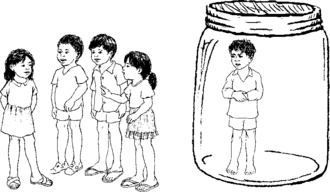Hesperian Health Guides
Why communication is important
HealthWiki > Helping Children Who Are Deaf > Chapter 1: Hearing difficulties and communication > Why communication is important
| Communication happens when we understand what is being said to us and respond, and when we express our thoughts, needs, and feelings so they can be understood. |
Contents
The loneliness of a deaf child

For a child, being deaf can be like living with a glass wall around him. A child who is deaf can see people talking but he cannot understand what they are saying.
People can interact with each other because they have learned a language to communicate with. But a deaf child cannot learn a language that he does not hear. This means many deaf children grow up not being able to learn or use a language to interact with others around them.
People have a strong need to communicate with each other and to build relationships. When a child does not have the communication skills to relate to other people, and when other people do not know how to communicate or relate with him, he may be left alone most of the time, even by the people closest to him. After a while he becomes socially isolated.

Communication for learning and thinking

Children use communication to learn about the world, to relate to other people, to express themselves, and to think and develop their ideas. Without some form of communication, a deaf child cannot fully develop her mind or abilities.
The more children are able to learn a language, the more they can understand their world, think and plan, and develop close relationships with the people around them.
For more information about language and children's development, see Chapter 2.
 Hi. My name is Carmen and I use my hands to communicate because I am deaf. I went to a school for deaf children in Nicaragua. There, we made up Nicaragua's first sign language. I still remember what it was like to finally have people understand me.
It is as though I have colors to paint the whole world, where before I had only gray. |
Anita's story

Anita was born almost completely deaf, but her parents did not realize this until she was 4. When she was a baby, they only saw that she was healthy and energetic. Until her sister Lora was born, they didn't worry that Anita wasn't learning to talk. They thought she was just taking a little longer to do this than other children.
"Are you sure she can hear?" a neighbor asked one day. "Oh yes," said Anita's mother, Eva. Eva called her name loudly and Anita turned her head.
But when she was 3, Anita could still only say a few words. Her 2-year-old sister Lora was saying new words every day. Lora smiled and laughed more than Anita when Eva talked or sang to her. So Eva talked and sang more to Lora than to Anita. Lora asked for things, sang simple songs, and played happily with other children. Anita played by herself, since playing with other children often ended in fighting or crying.

Once in the village market, Lora asked for a hair ribbon and Eva bought her one. A moment later Anita quietly picked up another ribbon and began to put it in her hair. Embarrassed and upset, Eva took it away. Anita threw herself on the ground and began to kick and scream.

When Anita's father heard what had happened in the market, he looked angrily at Anita and said, "When will you learn to ask for things? You're 4 years old and still don't even try to talk. Are you stupid or just lazy?"
Anita looked at her father. She could not understand what her father said. But she understood the angry look on his face. Tears rolled down her cheeks. Her father softened and took her in his arms.
When the family sat down that evening to talk, Eva remembered her neighbor's question about Anita's hearing. She decided to try making different sounds behind Anita's back to see what she could hear. When the family saw that Anita did not respond to most of the sounds, they realized she was deaf. It was a very sad day for them all.
Anita's family worried that Anita would never be able to develop like other children.

Anita's parents did their best to help her. They were very busy taking care of their other children and their fields, so it was hard for them to give Anita the attention she needed. They hoped that someday Anita could have a full life, but they did not know how they could help her.

Anita and other deaf children may behave badly because they do not understand what they should do. Because Anita cannot hear words clearly, it is much more difficult for her to learn her family's language. So she has trouble understanding what people want and telling them what she wants.
It is no surprise that children who cannot hear well sometimes feel lonely or forgotten, develop behavior problems, or take longer to learn to relate to other people. Anita needs help to develop language so she can understand the world around her.
Omar's story

Omar was born with normal hearing and was a very talkative boy. For a couple of years he had many ear infections. His family could not afford to buy medicine to treat them. With each infection he lost a little more hearing. By the time he was 4 he could not understand his parents when they talked to him because their speech sounded fuzzy and unclear to him. He just looked at them in a puzzled way, and spoke less and less.

can still hear
some sounds.
Omar's grandfather, who had lost much of his hearing in his old age, suggested some things that might help. He said he usually understood people fairly well by using what hearing he still had and by watching people's lips.
But, Omar's grandfather said, it was sometimes difficult to understand people because so many words look alike on the lips. He wondered whether a hearing aid would help Omar.
Omar's father took him to a hearing clinic in the city. The people there tested his hearing and thought that a hearing aid would help him. So Omar's father borrowed money from his cousin and Omar was fitted with a hearing aid. The family practiced with Omar to help him understand words and speak correctly. Since he is still a little boy, Omar's hearing aid will need many new parts as he—and his ears—grow bigger.
Some children like Omar, who can hear a little, may be able to speak and read lips. A hearing aid can help Omar because he has some hearing. It also helps that he understood language before he became deaf.

Julia's story

Irene and Pedro realized their daughter Julia was deaf when other children her age were talking but she had not yet learned to speak.
Irene was determined that Julia would have every chance to learn and succeed in life. Despite her doubts, fears, and many questions, Irene thought, "Just because she can't hear doesn't mean she can't learn how to do things."
Irene remembered the time she met a foreign woman who spoke a different language. While they weren't able to talk to each other, they used gestures and acted out what they wanted to say. Even though it took more time and they sometimes misunderstood each other, they enjoyed themselves.

So to communicate with Julia, the whole family made up gestures and "home signs" and used them together. Even the neighbors began to learn how to use Julia's home signs.
Then Irene asked a teacher at the village school when Julia could start. The teacher said that she did not have any way to teach deaf children. She told Irene about a school that might be able to teach Julia, but it was a 2-hour walk there and back. Pedro and Irene wondered how old Julia would have to be before she could go there by herself every day.
The human desire to communicate is very strong. When parents learn how to communicate with gestures and home signs, little girls like Julia can blossom into smart, happy children.

Education for disabled children in Nicaragua

For many years Nicaragua was ruled by the Somoza family. They controlled most of the country's wealth and provided the people with few services.

The Somozas did not consider education important for everyone. They felt that people who spent their lives working in the fields did not need to go to school. Somoza himself said, "I don't want educated people, I want oxen!"
As a result, most people in Nicaragua could not read or write. Many poor children, children with disabilities and almost all children in rural areas—especially children who were deaf—could not go to school.


When everyone is committed to education, deaf children can have the chance to learn, go to school, and develop their capabilities just like everyone else!
Carmen's story
Some months after I was born, an illness spread quickly through many children in my village. I got sick too, with a very high fever. My parents were thankful when I got better, but they realized that the illness had left me deaf. As I grew older, we all felt frustrated because it was so hard to communicate even simple ideas or needs. My family did not know how to communicate with me or how to teach me.

After the revolution in Nicaragua, a school for deaf children opened and my parents took me there. They realized the school could help me in ways they could not. The teachers at the school tried to teach us all to read lips and to speak. Even though many of us could not learn to read lips and speak well, just being together began to open up the world for us.

Many of us started school as older children. We communicated using "home signs" we had used with our families, and which were all different. But we taught each other these signs and made up new signs together. It was easy for us to use signs to communicate. As we used more and more signs, it grew into a real language. Soon we were able to communicate many things to each other, about our families and friends, our plans and dreams, and things that happened to us.
Language makes learning and community possible
Carmen and the other deaf young people in Nicaragua proved to the world that sign language is a natural and complete language that develops in a community. As with any other language, to use sign language you need a group of people to use it with.
As Carmen and other children developed the Nicaraguan sign language and their communication skills, they also developed abilities to describe things, solve problems, and make their feelings, needs, and ideas known. Sign language not only gave the children a way to communicate, it helped them develop their ability to think.


One of the reasons the Nicaraguan children developed such a complete language is there were many children using it. They could do this because the people of Nicaragua decided to put more of their resources into education. They started an educational reform movement that created a strong school system for all children—including children who were deaf or could not hear well.
Coming together for deaf rights
Thanks to the Nicaraguan people's struggle to make education available to all, many young deaf people were brought together in schools for the first time. In one generation, the children began to produce a new and different form of communication—which developed into Nicaraguan Sign Language.
By the mid-1980s, these young deaf adults began meeting and working to promote their rights as deaf people. They formed the National Association of the Deaf of Nicaragua (ANSNIC). The people of ANSNIC helped to develop and promote Nicaraguan Sign Language, publishing a dictionary as well as a book for children. They worked with the Ministry of Education to begin to include signing in the deaf schools, and to improve the programs for deaf education.
Today, ANSNIC is a powerful group in Nicaragua that works for the rights of deaf people and also serves as a social center for its members.




